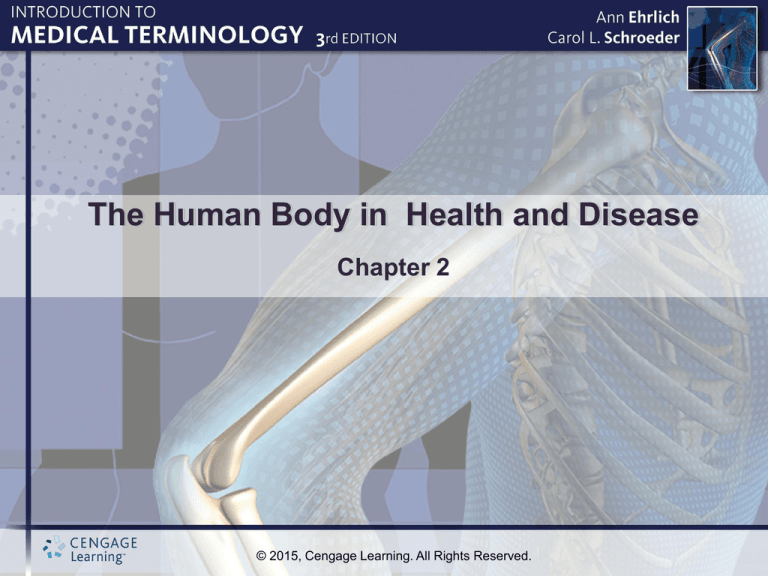
The Human Body in Health and Disease
Chapter 2
© 2015, Cengage Learning. All Rights Reserved.
Anatomic Reference Systems
• Describe the location and functions of body
parts using:
–
–
–
–
Body planes
Body directions
Body cavities
Structural units
(continues)
© 2015, Cengage Learning. All Rights Reserved.
© Cengage Learning
Anatomic Reference Systems
© 2015, Cengage Learning. All Rights Reserved.
(continues)
© Cengage Learning
Anatomic Reference Systems
(continues)
© 2015, Cengage Learning. All Rights Reserved.
© Cengage Learning
Anatomic Reference Systems
© 2015, Cengage Learning. All Rights Reserved.
(continues)
© Cengage Learning
Anatomic Reference Systems
(continues)
© 2015, Cengage Learning. All Rights Reserved.
© Cengage Learning
Anatomic Reference Systems
© 2015, Cengage Learning. All Rights Reserved.
(continues)
© Cengage Learning
Anatomic Reference Systems
© 2015, Cengage Learning. All Rights Reserved.
Cytology
• The study of the formation, structure, and
function of cells, including:
– Chromosomes
– DNA
– Genetics
(continues)
© 2015, Cengage Learning. All Rights Reserved.
© Cengage Learning
Cytology
© 2015, Cengage Learning. All Rights Reserved.
Histology
• The study of tissues, which are composed
of cells that join together to perform specific
functions, including:
–
–
–
–
Stem cells
Epithelial tissues
Connective tissues
Muscle tissue
© 2015, Cengage Learning. All Rights Reserved.
Glands
• Specialized cells that secrete material used
elsewhere in the body, including:
– Exocrine glands
– Endocrine glands
(continues)
© 2015, Cengage Learning. All Rights Reserved.
© Cengage Learning
Glands
© 2015, Cengage Learning. All Rights Reserved.
Organ and Body Systems
• Body parts are organized into systems
according to function.
• Examples:
– Skeletal system
– Muscular system
– Cardiovascular system
© 2015, Cengage Learning. All Rights Reserved.
Pathology
• The study of structural and functional changes
caused by disease.
© 2015, Cengage Learning. All Rights Reserved.
Key Word Parts and Definitions
• aden/o
– gland
• adip/o
– fat
• anter/o
– before, front
• caud/o
– lower part of body, tail
(continues)
© 2015, Cengage Learning. All Rights Reserved.
Key Word Parts and Definitions
• cephal/o
– head
• cyt/o, -cyte
– cell
• end-, endo– in, within, inside
• exo– out of, outside, away from
(continues)
© 2015, Cengage Learning. All Rights Reserved.
Key Word Parts and Definitions
• hist/o, histi/o
– tissue
• -ologist
– specialist
• -ology
– the science or study of
• path/o, -pathy
– disease, suffering, feeling, emotion
(continues)
© 2015, Cengage Learning. All Rights Reserved.
Key Word Parts and Definitions
• plas/i, plas/o, -plasia
– development, growth, formation
• poster/o
– behind, toward the back
• -stasis, -static
– control, maintenance of a constant level
© 2015, Cengage Learning. All Rights Reserved.
Questions to Get You Thinking
© 2015, Cengage Learning. All Rights Reserved.
Question
A chromosome is larger than a gene.
True or False?
© 2015, Cengage Learning. All Rights Reserved.
Question
Peas have 14 pairs of chromosomes and pigeons
have 80. How many do humans have?
a. 100
b. 145
c. 46
© 2015, Cengage Learning. All Rights Reserved.
Question
Stem cells die after a determined life span.
True or False?
© 2015, Cengage Learning. All Rights Reserved.
Question
A communicable disease and a contagious
disease are the same thing.
True or False
© 2015, Cengage Learning. All Rights Reserved.





